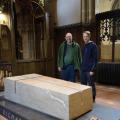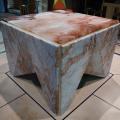3D drawings and printing are all part of this stonemason’s repertoire
James Elliott had greatness thrust upon him as the man who crafted the new tomb of Richard III in Leicester Cathedral. The project made full use of the problem solving abilities he more usually uses in (slightly) less exalted projects.
There was probably no higher profile project in stone last year than the new tomb of Richard III at Leicester Cathedral. The lines of the Swaledale Fossil limestone with its deeply incised cross standing on a slab of Irish Blue limestone are pleasingly, if deceptively, simple.
 Without any decoration to hide minor imperfections there could be no imperfections – hard enough to achieve when the piece is square, but the tomb is not square, it is a trapezoid.
Without any decoration to hide minor imperfections there could be no imperfections – hard enough to achieve when the piece is square, but the tomb is not square, it is a trapezoid.
Figuring this was going to be the most unusual job of his life, James Eliott, whose workshops are on Market Overton industrial estate in Rutland, employed a film-maker, Alex J Wright, to record the making of the tomb – and you can watch the films of the different aspects of the work on the James Elliott website.
It took six months to make the memorial and, therefore, six months of filming. “I didn’t budget it in. It just became very important. It is an interesting subject and you need to have records. But it was expensive... yes, it was.”
James does not know how he was chosen for the project. He was visited first by an architect from van Heyningen & Haward Architects, who designed the memorial. He was interviewed but was not told what the project was. Neither was price discussed.
It might have been his computer design skills; his demonstrable problem solving abilities; the ABS 3D printer he uses to create his own tools and accessories; the fact he makes his own finishing paste to achieve just the finish he wants (he does not like to see too high a polish on stone because he says then all you see is a reflection rather than the stone). Whatever swung it, three months later he received an email asking him if he wanted to make the tomb for Richard III.
He was also commissioned to make a new altar for the cathedral, which was, again, complicated because of the angles involved (see the picture on the left).  It is made of alabaster from British Gypsum’s Fauld Mine backed by Carrara marble to give it strength. The slabs of stone were cut using a hand saw to get the angles right and were glued up using jigs James design and printed on his 3D printer to hold each piece at precisely the correct angle.
It is made of alabaster from British Gypsum’s Fauld Mine backed by Carrara marble to give it strength. The slabs of stone were cut using a hand saw to get the angles right and were glued up using jigs James design and printed on his 3D printer to hold each piece at precisely the correct angle.
James also had to find some way of polishing the Swaledale Fossil limestone inside the cross cut on the top of the memorial. Mark Ward, who works with him, devised a pneumatic tool for carrying out the work. It took four days to achieve the required finish.
The skills James used to make the Richard III memorial and the new altar for the cathedral in Leicester were honed on less high profile projects over more than 30 years. His day-to-day work is often high end domestic bathrooms, although he says: “I get quite a lot of very niche projects.”
James likes to work stone by hand, but that does not mean he does not like computers, just that he is not a fan of computerised machinery.
He uses a Wacom tablet to design his work and produce 3D drawings to show customers what their projects will look like using photographs of the actual stone that will be used. “People are impressed when they get a picture of their finished bathroom before I have even cut the first slab of stone.” 3D drawings also identify any errors in the work of designers, which is usually in 2D. A 3D picture makes any inconsistencies immediately apparent as well as showing up anything that simply does not look right.
James even has his own microscope to examine the stones he is using and a pendulum slip tester so when he is producing flooring he can experiment with finishes to find the most appropriate slip resistance without having to send each away for testing.
He does not like being constrained in his designs by off-the-peg solutions such as plumbing accessories, nor even off-the-peg tools. So he designs and makes his own using his 3D printer, even if some of them are then produced in metal, often by JC Engineering just a few units away on the same industrial estate. He likes to produce a physical model for the metalworkers to follow as it discourages them from making their own amendments to his designs.
James has designed overflow pipes and covers, and plug hole grills on sinks and showers because those commercially available “look pants”, he says.
The 3D printer cost James more than any of his stone machinery, and now he is planning to buy another one. He says it will cost “six figures” but will be more sophisticated.
He has even 3D printed pipes for the water management system he designed and is currently updating in his workshop so it can cope with the increased demand for his work.
The reason James likes working stone by hand is because he believes it is more controllable. You need some machinery, of course, and James has three saws, including a Kolb K3 tile cutter and a Terzago GLS 35 with a lathe, a BRM 2300 milling machine and Mordenti polisher. He would like a wire saw but is not impressed with any he has seen so far. He says he might buy a second hand one and modify it.
What he does not have is a saw that was capable of the depth of cut required for the cross in the Richard III memorial. Instead he gave it to Tim Riley of T&C Trading in Newark to cut on his 900mm Spielvogel. James: “I gave it to Tim Riley because he’s the only person I know who’s as anal as I am about the accuracy of his machines.”
The 50mm wide x 350mm deep cuts of the cross created the danger of the stone breaking as it was transported and James, with the help of Danny Carey from Sprint Lifting Equipment Ltd, designed a cage for moving it.
James, who will be 50 this year, has set himself up as a sole trader because he believes some people hide behind limited company status to avoid their responsibilities. He is the son of a clergyman and has an uncompromising world view. “I don’t care about being rich,” he says. “I like to work for people who appreciate the work.” He also likes using stone from the British Isles as often as possible because of its low carbon footprint, although he does buy rare and unusual stone for his projects from specialist wholesaler McMarmilloyd in Wiltshire and sources other stones from wholesalers and producers.
James Elliott’s work is top end, but working by hand means minimising waste. He also only buys what he needs after the design details are finalised. Even the Swaledale block for the Richard III memorial was only 3.5mm bigger than its finished footprint across the diagonals in one direction. James proudly says the finished memorial was within 0.25mm of the dimensions on the architects’ drawing. This careful planning means James reckons to fill less than one skip a year for landfill.
He designed and 3D printed adjustable levellers that he had made in metal so the memorial would stand abosultely flat. He used a theodolite to make sure FWA got the floor level and made a glass fibre template so the grave would be the right size for the coffin carrying the King’s bones. James does not like to leave anything to chance.
A lot of consumers who can afford the work of James Elliott are at the top end of the income scale. But not all. James says some people of more modest means are simply discerning enough to spend their money on the best workmanship rather than mass produced goods.
Others in the stone industry also turn to James for solutions. He has a reputation for being able and willing to solve problems and produce work that others will not touch because it is too difficult and/or time consuming.
There has not always been the level of work that now enables James to pick and chose what he does. There have been times when he has filled in with a variety of other jobs, including fitting refrigeration systems and steel construction work, all of which has given him a variety of skills that he now finds useful in his business.
James trained as a cabinetmaker before joining Geoffrey Pike, one of the grand old names of stonemasonry in London that closed down in the 1990s. He now has four other people working alongside him, although only one of them is traditionally trained as a mason. James prefers engineers because he expects accuracy to two decimal points. It is why they do not use power tools for finishing.
For most of his career, James has been based in London but decided to move to Rutland four years ago “because the quality of life is better.”
